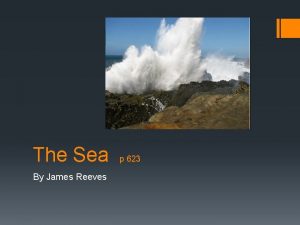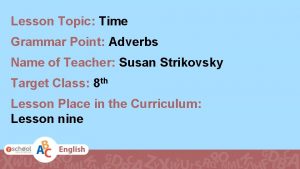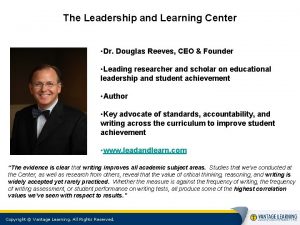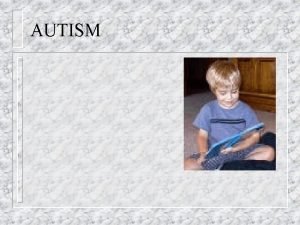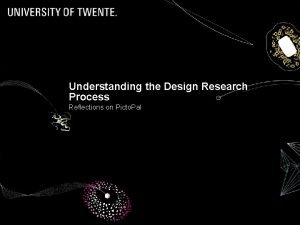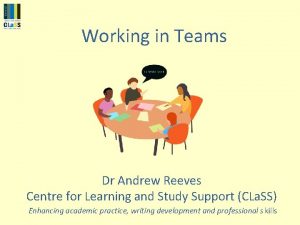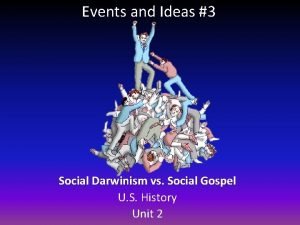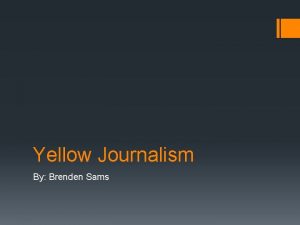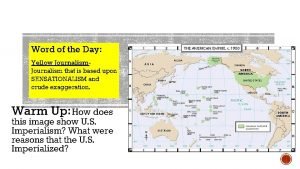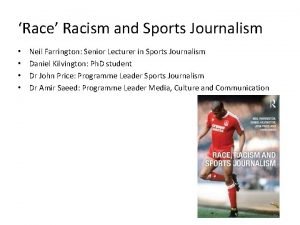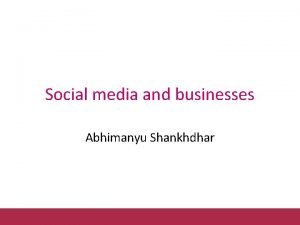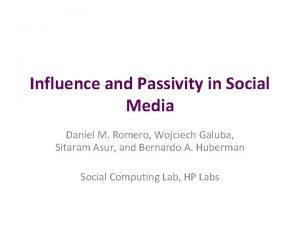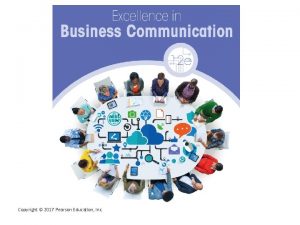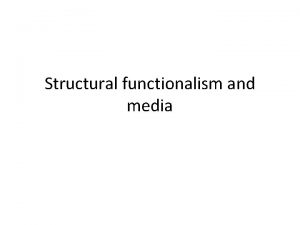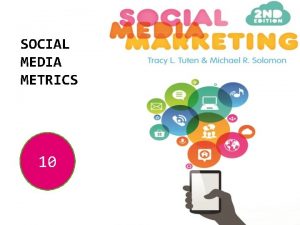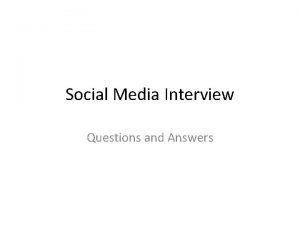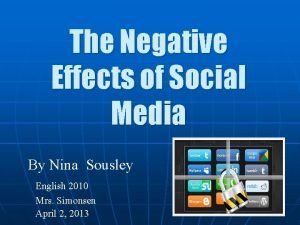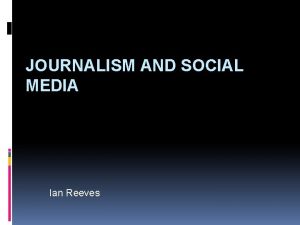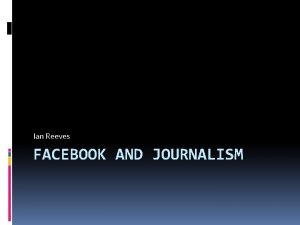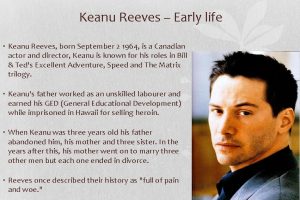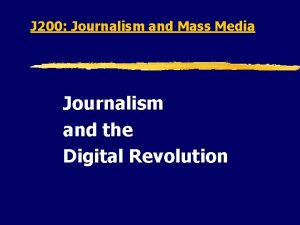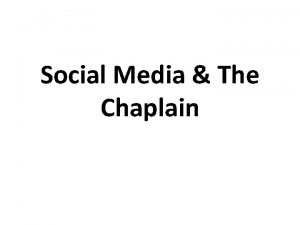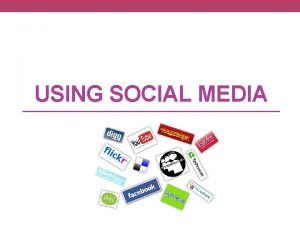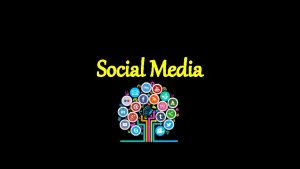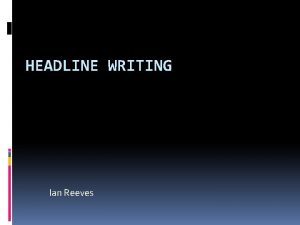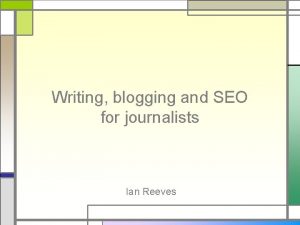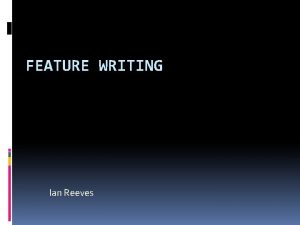JOURNALISM AND SOCIAL MEDIA Ian Reeves WHAT IS

































- Slides: 33

JOURNALISM AND SOCIAL MEDIA Ian Reeves

WHAT IS SOCIAL MEDIA? Websites and applications that enable users to create and share content and to organise networks of defined participants. Includes: some blogging social networking Microblogging Recommendation sites User content sharing

Time spent per medium

Time spent per medium

WHAT MAINSTREAM MEDIA CAN GAIN Newsgathering – social networks are often ‘first responders’ Telling better stories – there is always someone who knows more than you do Making better relationships – engaged users are more loyal, and more attractive to advertisers. They may even pay Attracting new users Finding sources – and their contacts - more easily

TYPES OF SOCIAL MEDIA/UGC USED BY MAINSTREAM MEDIA Message boards Comments on stories News UGC Non-news UGC Commissioned Blogs Reader blogs Microblogs User-generated data User questions Member spaces Member recommendations Off-site engagement

IMPORTANCE OF SOCIAL NETWORKS In 2008, Facebook had fewer users than CNN. com Now it dwarfs it by up to 60 x Social networks massively outperform news sites in terms of engagement 20 per cent of all internet time is spent on them Average daily time on Facebook is around 20 mins – 15 minutes more than most news sites

SOCIAL MEDIA PENETRATION As of September 2014: 71% of online adults use Facebook 23% of online adults use Twitter 26% use Instagram 28% use Pinterest 28% use Linked. In Figures from Pew Research (US survey)

Who uses social networks

SOCIAL MEDIA GROWTH 2012 -14

FREQUENCY OF SOCIAL MEDIA USE

USE OF SOCIAL MEDIA FOR NEWS

HOW CAN IT AFFECT NEWS COVERAGE? Iranian street protests of 2009

IRANIAN PROTESTS: SOCIAL MEDIA DILEMMAS Huge amount of noise and false information – eg 3 m protestors (only a few hundred thousand; Mousavi ‘house arrest’; president of monitoring committee ‘declared election invalid. ’) Little balance – conversation overwhelmingly in favour of Mousavi Self-selecting group, largely from liberal elite

IRAN PROTESTS: DIRECT BENEFITS Extended newsgathering possibilities – pictures and story leads Accumulation of ‘kudos’ within social media communities, plus traffic gains from links Relative simplicity of monitoring multiple news sources But usually a trade between speed and accuracy

WHEN SOCIAL MEDIA GOES WRONG • Newsnight and Lord Mc. Alpine • George Monbiot and Lord Mc. Alpine •

When social media goes wrong Quantas plane ‘crash’

When social media goes wrong Yarmouth reporter sacked after Tweets

When social media goes wrong Reddit and the Boston Marathon bomb suspects

Reuters guidance The tension is clear: Social networks encourage fast, constant, brief communications; journalism calls for communication preceded by fact-finding and thoughtful consideration. Journalism has many “unsend” buttons, including editors. Social networks have none. Everything we say online can be used against us in a court of law, in the minds of subjects and sources and by people who for reasons of their own may want to cast us in a negative light.

Reuters guidance While, obviously, we cannot control what others may post on our accounts, we must maintain constant awareness when posting to Facebook, Twitter and other online fora that we are flying without a net, and that an indiscretion lasts forever. At all costs, we must avoid flame wars, incendiary rhetoric and loose talk. We should also remember that by friending or following someone, we may be giving out the identity of a source. Everything depends on our keeping trust.

Reuters guidance In other words, be careful. By all means, explore ways in which social media can help you do your job. But before you tweet or post, consider how what you’re doing will reflect on your professionalism and our collective reputation. When in doubt, talk to colleagues, your editor or your supervisor.

Social media guidelines from around the world http: //kellyfincham. com/international-socialmedia-guidelines-for-journalists/123

IMPORTANT CAVEATS Usage of social media sites is highly uneven – beware thinking it is representative The 90 -9 -1 rule of participation inequality holds

IMPORTANT CAVEATS “People very often don’t want a conversation. People’s interest in media is very often as background. The earliest investigations into media going back the foundation of Gallup indicate that people are not as absorbed in media as the creators of media. “ – Adrian Monck.

SEARCHING SOCIAL MEDIA Twitter advanced search Gramfeed Facebook Graph search – but note feature no longer supported Itouchmap. com – finds longitude and latitude, which you can use to search on twitter. Yomapic, Echosec, SAM Desk, Geofeedia can all help you find pictures based on their location.

SOCIAL MEDIA VERIFICATION The Verification Handbook – fantastic resource for checking details of social media postings, user generated content and other source material online The Verification Handbook for Investigative Reporting – a more pro-active resource for investigative use of social media

SOCIAL MEDIA VERIFICATION CHECKS Provenance: Is this the original piece of content? Source: Who uploaded the content? Date: When was the content created? Location: Where was the content created?

SOCIAL MEDIA VERIFICATION Remember how easy it is to mock up social media interactions: Lemmetweetthatforyou

SOCIAL MEDIA VERIFICATION Geolocation doesn’t give you the whole picture. If a user takes a photo from a closed network (like Whatsapp) and then posts it on Twitter – the image can trick the geolocation tools into thinking it was taken at a completely different time and place.

PHOTO VERIFICATION You can also use Tin Eye. https: //www. tineye. com/ Fotoforensics will tell you if an image has been tampered with. http: //fotoforensics. com/ If the photo is outside, you can also look at Google streetview or the Bing equivalent to compare landmarks.

VIDEO VERIFICATION Amnesty International has developed a tool to help verify Youtube footage

SOCIAL MEDIA – FURTHER READING AND VIEWING Ian Reeves: The Newspapers Handbook, see Chapter 7 Dan Gillmor – We, the media (full copies in library) Antony Bradley – A New Definition of Social Media Rusbridger video on Future of Journalism Clay Shirky – How social media can make history The evolving use of news on Twitter and Facebook
 Literary journalism vs traditional journalism
Literary journalism vs traditional journalism Literary journalism vs traditional journalism
Literary journalism vs traditional journalism Summary of the sea by james reeves
Summary of the sea by james reeves Slowly the tide creeps up the sand
Slowly the tide creeps up the sand Jennie reeves radiographers agency ltd
Jennie reeves radiographers agency ltd Dr douglas reeves
Dr douglas reeves Vanjedarno nasledjivanje
Vanjedarno nasledjivanje Keanu reeves
Keanu reeves Picto analysis example
Picto analysis example Miss reeves
Miss reeves Dr andrew reeves
Dr andrew reeves What is people as media
What is people as media Social thinking and social influence in psychology
Social thinking and social influence in psychology Social thinking social influence social relations
Social thinking social influence social relations Social darwinism paralleled the economic doctrine of
Social darwinism paralleled the economic doctrine of Hot and cold media
Hot and cold media Hot media and cold media
Hot media and cold media Benefits of transferring data over a wired network
Benefits of transferring data over a wired network Hot media and cold media
Hot media and cold media Similarities of journalism and literature
Similarities of journalism and literature Yellow journalism style
Yellow journalism style Yellow journalism examples
Yellow journalism examples Journalism based on sensationalism and crude exaggeration
Journalism based on sensationalism and crude exaggeration Neil farrington
Neil farrington Big data and social media analytics
Big data and social media analytics Abhimanyu shankhdhar, jims / social media and businss /
Abhimanyu shankhdhar, jims / social media and businss / Nine compositional modes in digital media
Nine compositional modes in digital media Challenges of media and information in economic
Challenges of media and information in economic Influence and passivity in social media
Influence and passivity in social media Nine compositional modes in digital media
Nine compositional modes in digital media Teori fungsionalisme
Teori fungsionalisme Social media objectives and metrics
Social media objectives and metrics Social media interview questions
Social media interview questions Social media negative effects on society
Social media negative effects on society


